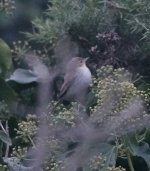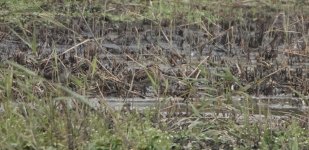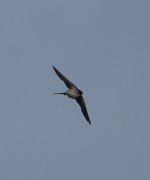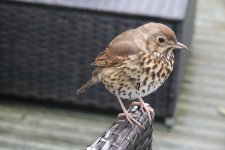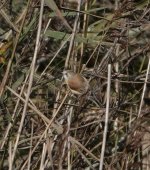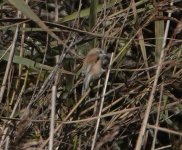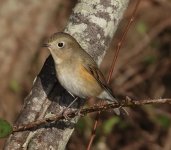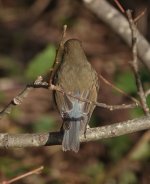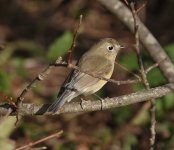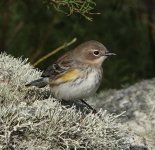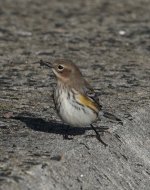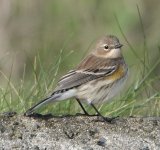-
Welcome to BirdForum, the internet's largest birding community with thousands of members from all over the world. The forums are dedicated to wild birds, birding, binoculars and equipment and all that goes with it.
Please register for an account to take part in the discussions in the forum, post your pictures in the gallery and more.
You are using an out of date browser. It may not display this or other websites correctly.
You should upgrade or use an alternative browser.
You should upgrade or use an alternative browser.
A Scilly Diary. (1 Viewer)
- Thread starter chowchilla
- Start date
More options
Who Replied?MKinHK
Mike Kilburn

This may come as a shock Dan, but Britain, or what's left of it, hasn't been the centre of the Universe for a good long while now, especially for those who have lived and birded elsewhere.
e.g. me - even as a good British colonial my 30 years of birding in Hong Kong would never see me calling my first UK Eastern Crowned Warbler or Eastern Curlew or Spoon-billed Sandpiper a lifer however exalted a position they may one day hold on my British list.
Cheers,
Mike
e.g. me - even as a good British colonial my 30 years of birding in Hong Kong would never see me calling my first UK Eastern Crowned Warbler or Eastern Curlew or Spoon-billed Sandpiper a lifer however exalted a position they may one day hold on my British list.
Cheers,
Mike
If you only look upon yourself as a 'world' birder guess it wouldn't be ... but it would be a lifer
This may come as a shock Dan, but Britain, or what's left of it, hasn't been the centre of the Universe for a good long while now, especially for those who have lived and birded elsewhere.
e.g. me - even as a good British colonial my 30 years of birding in Hong Kong would never see me calling my first UK Eastern Crowned Warbler or Eastern Curlew or Spoon-billed Sandpiper a lifer however exalted a position they may one day hold on my British list.
Cheers,
Mike
I’ve seen Americans say ‘that’s a county or state lifer’ too but it feels a bit weird to me.
You tell a non birder friend it’s a lifer you explain what lifer is then tell them you also saw one in Spain or wherever?
I get people prioritising their British list for whatever reason but surely something is a lifer or not.
I’m still happy when I get a welsh or Glamorgan tick no need to call it a lifer.
chowchilla
Well-known member
I mean, people can prioritise whichever bird lists they like for their own personal consumption, but the only list I've kept since the early 90s is a world list, since I began living outside the UK (in France, first time out - later Spain, and most recently, Australia).
I've spent nearly half my adult life outside the UK, so national lists became meaningless to me, personally. I have absolutely no idea how long my Australian bird list is, for example (around 600 probs), and I don't care to count. My world list is the only one I really care about. I have a 'Scilly list', but honestly, I'll probably dump that at the end of the year. I use it for entertainment purposes only on this thread.
FTR, my World List is 2841 (including two undescribed species from Peru), according to the IOC. If I ever compile a Birdlife International list it would probably grow to about 2860, at least; and if I include 'heard only' species, it would grow to over 3000. Not a huge world total by some lister's standards, but I'm happy with it!
I've spent nearly half my adult life outside the UK, so national lists became meaningless to me, personally. I have absolutely no idea how long my Australian bird list is, for example (around 600 probs), and I don't care to count. My world list is the only one I really care about. I have a 'Scilly list', but honestly, I'll probably dump that at the end of the year. I use it for entertainment purposes only on this thread.
FTR, my World List is 2841 (including two undescribed species from Peru), according to the IOC. If I ever compile a Birdlife International list it would probably grow to about 2860, at least; and if I include 'heard only' species, it would grow to over 3000. Not a huge world total by some lister's standards, but I'm happy with it!
Last edited:
Does that mean that Britania doesn't rule the waves anymore?This may come as a shock Dan, but Britain, or what's left of it, hasn't been the centre of the Universe for a good long while now, especially for those who have lived and birded elsewhere.
chowchilla
Well-known member
A couple of wee updates.
Remember that Booted Warbler I dipped at Higher Moors? Well, another one was found in the moat of the Star Castle, a mere ten minutes' walk away (albeit mostly steeply uphill...), and so off I set.
It was the peak of October migration. There were a lot of birders on the islands, and a lot of huffing and puffing as we moved uphill as fast as our ageing legs would allow us. I figured I'd responded pretty fast to this one, and yet there were at least three dozen people already peering into the moat on arrival. I guess some of them were already up on the Garrison; the rest were just superhumanly fast and fit.
The bird wasn't showing. Of course it wasn't. I felt strangely optimistic though, as there didn't seem to be many places for it to hide - the moat basically being a large ditch surrounding the Star Castle with some dense cover on one side. If it was still around it had to be hiding in there.
"This moat goes all the way around the back. It could be anywhere," said someone gloomily.
Oh. I didn't know that.
"Probably pissed off into the field over the back," muttered another (why are so many Poms so pessimistic? The bird had only just been found!)
As if on cue, a distinctly bicoloured warbler flew out of cover and landed in the brambles further back. Unless there's another species that has that characteristic colour pattern, we'd just see the Booted Warbler. A flurry of activity off to our right indicated that it had popped out the other side of the cover at a right angle to our position. We decamped en masse and hurried over, quietly of course so as not to scare it back into cover. It had apparently hopped out onto the grass by a bench in full view for a small group that appear to have anticipated that it would show on their side. Good field craft, see.
Then I saw it on the edge of the brambles. Unfortunately, it flew back into cover almost at once; but wait! It was climbing to the top of the vegetation, judging by the flicker of branches, and lo' and behold there it was! It hopped about for a bit at the top of the brambles, enabling me to get the usual crap photos (and I mean really crap), but I felt fantastic! All disappointment at not seeing the Higher Moors bird had vanished, and this surprisingly distinctive bird was finally in the bag.
A day or two before, I finally clapped eyes on a 'probable' Wilson's Snipe (I've still no idea if the debate is settled) readily visible as a very greyish-looking Snipe, from the Sussex Hide at Porth Hellick. I even managed to snaffle a lousy picture of three species of Snipe below. Those eagle-eyed amongst you should just about make out (from left to right) Wilson's, Common and Jack Snipe, all in the same pic! It's not every day anywhere on Earth that you capture three (maybe) species of Snipe in one pic. I'll take it.
I've seen Wilson's before, so I was in no hurry to go for this bird; and as it turns out, I was distinctly reluctant to go for a few other rarities on Scilly for the same reason, of which more later.
Remember that Booted Warbler I dipped at Higher Moors? Well, another one was found in the moat of the Star Castle, a mere ten minutes' walk away (albeit mostly steeply uphill...), and so off I set.
It was the peak of October migration. There were a lot of birders on the islands, and a lot of huffing and puffing as we moved uphill as fast as our ageing legs would allow us. I figured I'd responded pretty fast to this one, and yet there were at least three dozen people already peering into the moat on arrival. I guess some of them were already up on the Garrison; the rest were just superhumanly fast and fit.
The bird wasn't showing. Of course it wasn't. I felt strangely optimistic though, as there didn't seem to be many places for it to hide - the moat basically being a large ditch surrounding the Star Castle with some dense cover on one side. If it was still around it had to be hiding in there.
"This moat goes all the way around the back. It could be anywhere," said someone gloomily.
Oh. I didn't know that.
"Probably pissed off into the field over the back," muttered another (why are so many Poms so pessimistic? The bird had only just been found!)
As if on cue, a distinctly bicoloured warbler flew out of cover and landed in the brambles further back. Unless there's another species that has that characteristic colour pattern, we'd just see the Booted Warbler. A flurry of activity off to our right indicated that it had popped out the other side of the cover at a right angle to our position. We decamped en masse and hurried over, quietly of course so as not to scare it back into cover. It had apparently hopped out onto the grass by a bench in full view for a small group that appear to have anticipated that it would show on their side. Good field craft, see.
Then I saw it on the edge of the brambles. Unfortunately, it flew back into cover almost at once; but wait! It was climbing to the top of the vegetation, judging by the flicker of branches, and lo' and behold there it was! It hopped about for a bit at the top of the brambles, enabling me to get the usual crap photos (and I mean really crap), but I felt fantastic! All disappointment at not seeing the Higher Moors bird had vanished, and this surprisingly distinctive bird was finally in the bag.
A day or two before, I finally clapped eyes on a 'probable' Wilson's Snipe (I've still no idea if the debate is settled) readily visible as a very greyish-looking Snipe, from the Sussex Hide at Porth Hellick. I even managed to snaffle a lousy picture of three species of Snipe below. Those eagle-eyed amongst you should just about make out (from left to right) Wilson's, Common and Jack Snipe, all in the same pic! It's not every day anywhere on Earth that you capture three (maybe) species of Snipe in one pic. I'll take it.
I've seen Wilson's before, so I was in no hurry to go for this bird; and as it turns out, I was distinctly reluctant to go for a few other rarities on Scilly for the same reason, of which more later.
Attachments
Last edited:
chowchilla
Well-known member
So, as I said in my previous post, I don't always go for birds. Anyone keeping tabs on the rather impressive Autumn so far on Scilly may have suspected this, as not every rare bird stars on my posts. Sometimes I'm busy; but more typically I will go for anything I really want to see. If it's a lifer, then I will indeed make the effort. The Long-tailed Duck that turned up around St Martin's on the day I went for the Little Bunting on the same island, for example. If it had stayed in the harbour, in all likelihood we would all have seen it from the ferry, but it didn't, and so we didn't. Apparently it's still around... If, at any time, I happen to go in its general direction whilst looking for something else or just enjoying a winter's day out, then I'll have a look, and maybe add it to my Scilly list; but seriously, no stress. I'm OK not to see everything!
The same applies for the many Wryneck and Yellow-browed Warbler that have turned up on the islands. If I happen to find one myself, that's great; if I happen to be passing by as someone else finds one, again great; but I'm fine with not seeing another of either this year. Occasionally, if a bird is reported close by, or I just fancy a walk, then I might go. This happened the other week when a Snow Bunting turned up in the Peninnis Allotments. I strolled up there, in no particular hurry and was not surprised to discover that the bird had gone by the time I'd got there. I planned to go for a walk anyway, and so made my way up the hill and across onto the Peninnis Farm Trail. It was a windy day, but a surprising number of birds were around and flocks of Finches, Meadow Pipits, Starlings, and I suspect rarer stuff - just by the sheer volume of birds - passed over constantly. Despite the blustery conditions, they seemed quite happy to feed in exposed fields on the very crown of Peninnis as well. In only the second field on the Peninnis Farm Trail, I could see lots of Chaffinches creeping around amongst the sparse grass cover, and lo' and behold, they were accompanied by a Snow Bunting. The same bird? Maybe, but it could easily have been another. It was a pleasant surprise either way, and a reminder that finding your own birds is always pretty satisfying.
A long-staying Bar-tailed Godwit was later seen at Porthmellon Beach, and surprisingly appears to be the first I've seen on Scilly this year. The minor lull in the birding over the past few days was set to dramatically change as a Blyth's Reed Warbler was lured out for brief sightings in the same Star Castle moat that turned up the Booted Warbler. This species would be a lifer for me, and so I definitely wanted to go for it. I got a little held up, and in the short delay, a Pallid Swift was confirmed in the same location! Two 'possible Pallid Swift' had been seen the day before on the far side of St Mary's, but as is the way with Swifts, were very mobile. A likely third bird was seen on St Agnes. This bird was also a lifer!
I finally got my act together and made haste towards The Garrison. As with the Booted Warbler twitch, it was all uphill. On the way past the police station, which is on a very steep hill, I encountered another birder looking skywards. He confirmed my suspicion that he was also looking for the Swift, but had yet to see it. We split up, taking separate routes up to the Garrison (I took the weird 'secret' route under a block of flats and up some winding stairs to Sallyport), and we convened in front of the Eastern Boundary, with recent reports suggesting that the bird was being seen over town. From here, we had a grandstand view of the whole of Hugh Town. We'd barely made eye contact coming from opposite directions when a Swift appeared over the rooftops of Sallyport from the direction of the Star Castle. It was a fine sunny day, so the light was excellent. What was immediately apparent about this bird was the rather languid flight - quite distinct from a Common Swift. As the bird arced out over town, we were able to view it at our leisure. The bird wasn't obviously paler, but it did have a contrast in the wings. The primaries and secondaries were noticeably paler than the coverts. It was clear as day as the bird flew below out elevated position and could be seen against buildings and trees. It was clearly a Pallid Swift.
After several minutes of watching, the bird became increasingly distant, until I could just make it out flying towards Porthloo. It was seen by other observers thereafter on other parts of St Mary's. I decided to head further up to try and locate the warbler. With the Blyth's Reed Warbler still not relocated, I was not optimistic, and sure enough, after a good half an hour of searching, several of us had to concede that we were probably flogging a dead horse. Of course, as soon as one gives up, the bird is relocated; but not this time. No one saw or heard it again. These days, Blyth's Reed Warbler is not super rare in the UK, so I'm not panicking; I will catch up with this species at some point, no doubt. The Pallid Swift is a much bigger prize, in the grand scheme of things.
I headed back home and did a bit of shopping. No sooner did I begin to lug my purchases back home, then the Pallid Swift was relocated back on The Garrison once more. I was happy to ignore its proximity, having had great views earlier, but... something told me this was worth taking a second look at. It was apparently putting on quite the show for the gathered masses as it plied its way up and down the northern slopes below the Star Castle. Long story short, I decided to go back for a second look. I was not to be disappointed. Upon arrival, the bird was swooping back and forth at low altitude. At one point, I casually raised my hand to see how close it would come as it flew towards me. I'd say it passed less than a metre from my finger tips. It did the same for others, as if in curiosity at these strange bipedal creatures watching its progress. Of course, I didn't have my camera with me.
The previous day (or was it two?) I had gone on an abortive trip in search of a Pechora Pipit near Content Farm. About a hundred birders walked away disappointed that day, but worse still, the heavens opened as we left. It was a long walk back and I hadn't come out with my protective rucksack. My camera was getting soaked. I was fortunate to get picked up by Spider a little way down the road, and I crammed myself into an already packed van full of soggy birders. I think in the back of my mind, I took one look at the sky and decided not to bring my camera for the Swift. As I got up onto The Garrison, it became blatantly obvious that this was a miscalculation on my part as the sky steadfastly refused to rain. Those with cameras got absolutely crippling photographs as it repeatedly did ultra close fly-bys. Cracking bird, but no icing on the cake in the form of pictures! Unwise in retrospect.
The same applies for the many Wryneck and Yellow-browed Warbler that have turned up on the islands. If I happen to find one myself, that's great; if I happen to be passing by as someone else finds one, again great; but I'm fine with not seeing another of either this year. Occasionally, if a bird is reported close by, or I just fancy a walk, then I might go. This happened the other week when a Snow Bunting turned up in the Peninnis Allotments. I strolled up there, in no particular hurry and was not surprised to discover that the bird had gone by the time I'd got there. I planned to go for a walk anyway, and so made my way up the hill and across onto the Peninnis Farm Trail. It was a windy day, but a surprising number of birds were around and flocks of Finches, Meadow Pipits, Starlings, and I suspect rarer stuff - just by the sheer volume of birds - passed over constantly. Despite the blustery conditions, they seemed quite happy to feed in exposed fields on the very crown of Peninnis as well. In only the second field on the Peninnis Farm Trail, I could see lots of Chaffinches creeping around amongst the sparse grass cover, and lo' and behold, they were accompanied by a Snow Bunting. The same bird? Maybe, but it could easily have been another. It was a pleasant surprise either way, and a reminder that finding your own birds is always pretty satisfying.
A long-staying Bar-tailed Godwit was later seen at Porthmellon Beach, and surprisingly appears to be the first I've seen on Scilly this year. The minor lull in the birding over the past few days was set to dramatically change as a Blyth's Reed Warbler was lured out for brief sightings in the same Star Castle moat that turned up the Booted Warbler. This species would be a lifer for me, and so I definitely wanted to go for it. I got a little held up, and in the short delay, a Pallid Swift was confirmed in the same location! Two 'possible Pallid Swift' had been seen the day before on the far side of St Mary's, but as is the way with Swifts, were very mobile. A likely third bird was seen on St Agnes. This bird was also a lifer!
I finally got my act together and made haste towards The Garrison. As with the Booted Warbler twitch, it was all uphill. On the way past the police station, which is on a very steep hill, I encountered another birder looking skywards. He confirmed my suspicion that he was also looking for the Swift, but had yet to see it. We split up, taking separate routes up to the Garrison (I took the weird 'secret' route under a block of flats and up some winding stairs to Sallyport), and we convened in front of the Eastern Boundary, with recent reports suggesting that the bird was being seen over town. From here, we had a grandstand view of the whole of Hugh Town. We'd barely made eye contact coming from opposite directions when a Swift appeared over the rooftops of Sallyport from the direction of the Star Castle. It was a fine sunny day, so the light was excellent. What was immediately apparent about this bird was the rather languid flight - quite distinct from a Common Swift. As the bird arced out over town, we were able to view it at our leisure. The bird wasn't obviously paler, but it did have a contrast in the wings. The primaries and secondaries were noticeably paler than the coverts. It was clear as day as the bird flew below out elevated position and could be seen against buildings and trees. It was clearly a Pallid Swift.
After several minutes of watching, the bird became increasingly distant, until I could just make it out flying towards Porthloo. It was seen by other observers thereafter on other parts of St Mary's. I decided to head further up to try and locate the warbler. With the Blyth's Reed Warbler still not relocated, I was not optimistic, and sure enough, after a good half an hour of searching, several of us had to concede that we were probably flogging a dead horse. Of course, as soon as one gives up, the bird is relocated; but not this time. No one saw or heard it again. These days, Blyth's Reed Warbler is not super rare in the UK, so I'm not panicking; I will catch up with this species at some point, no doubt. The Pallid Swift is a much bigger prize, in the grand scheme of things.
I headed back home and did a bit of shopping. No sooner did I begin to lug my purchases back home, then the Pallid Swift was relocated back on The Garrison once more. I was happy to ignore its proximity, having had great views earlier, but... something told me this was worth taking a second look at. It was apparently putting on quite the show for the gathered masses as it plied its way up and down the northern slopes below the Star Castle. Long story short, I decided to go back for a second look. I was not to be disappointed. Upon arrival, the bird was swooping back and forth at low altitude. At one point, I casually raised my hand to see how close it would come as it flew towards me. I'd say it passed less than a metre from my finger tips. It did the same for others, as if in curiosity at these strange bipedal creatures watching its progress. Of course, I didn't have my camera with me.
The previous day (or was it two?) I had gone on an abortive trip in search of a Pechora Pipit near Content Farm. About a hundred birders walked away disappointed that day, but worse still, the heavens opened as we left. It was a long walk back and I hadn't come out with my protective rucksack. My camera was getting soaked. I was fortunate to get picked up by Spider a little way down the road, and I crammed myself into an already packed van full of soggy birders. I think in the back of my mind, I took one look at the sky and decided not to bring my camera for the Swift. As I got up onto The Garrison, it became blatantly obvious that this was a miscalculation on my part as the sky steadfastly refused to rain. Those with cameras got absolutely crippling photographs as it repeatedly did ultra close fly-bys. Cracking bird, but no icing on the cake in the form of pictures! Unwise in retrospect.
chowchilla
Well-known member
I'll admit that I'm a little lacking in motivation right now; it might be the change in weather (it's a lot colder, at least for my tropical blood) and a lot darker in the evenings. I hadn't experienced daylight saving for 15 years! Be that as it may, I really ought to do an update.
You know that bit where I said I didn't particularly like pipits, and therefore didn't go for several of them? Well, I went for a pipit, so I'm clearly a hypocrite. This particular bird was doing something very odd indeed for a rare pipit: it was sticking around and even showing rather well for people. So, what the heck... off I went.
Some half an hour later, I found myself in Pungies Lane on the edge of Telegraph watching small flocks of Meadow Pipits wheeling about. I strained my ears at these birds to see if any of them sounded odd. I heard, and then got sight of, a flyover Skylark by doing so; my first for the islands. I turned my attention to the field in front of me, because it was evident that within it were quite a few more pipits creeping about. A Reed Bunting caught my eye on the field boundary for all of two seconds before it dropped out of sight. Another new bird for the island list; and the dull sky was clearing a bit, so all in all, a worthwhile trip - plus the hike up here had cleared a few cobwebs. I need to just do this more often, birds or no birds, quite frankly.
I began to walk towards the main bit of Telegraph as many of the pipits were commuting between the aforementioned field and another further up that borders the road known for some reason as McFarland's Down. It isn't a down, or even a hill, though it's on a hill. It slopes down towards the north end of the island and is even lumpier than my mattress. Fun for cycling down. Anyway, as I approached, another little cloud of pipits rose from the field behind me. One of them did a decidedly un-Meadow Pipit prrrrb call as it went over - just the once. I got onto what I was certain was the bird as it bounced over and disappeared over the hedge. After several minutes of checking the field, I was unable to relocate it, but it didn't really matter; I mean it was only a pipit. But, knowing this bird was out there, I had taken the trouble to learn the call. It was a Red-throated Pipit, and it was a lifer! Pipit or nay, I'll take it. What's more, I had it to myself. This is unusual for the month of October, so either this species is held in contempt for having the temerity not to be as rare as, say, a Pechora, or everyone had already seen it. There was no denying that it wasn't the first seen on Scilly this year - flyovers seen by one or two observers being typical of the species - but this particular bird had definitely been seen by a fair number of people already as it had been around for days.
A few days later, and I was hurrying towards the Dump Clump for a reported Red-breasted Flycatcher. The dump clump is the rather ungracious birding name for Doily Woods, a picturesque patch of woodland on the edge of town, sandwiched between Hugh Town and the rubbish dump. The latter no doubt giving it it's name. Anyways, I'm rambling... On arrival there were several birders in attendance, saving me the trouble of wondering where in the woods it might be. Of course it had been showing well minutes earlier and had now disappeared. How often have birders heard that?
Fortunately, the bird didn't make me wait too long. As I edged round for a side view of the tree it had been frequenting, a movement high up revealed itself as a Red-breasted Flycatcher. Another lifer! I've seen lots of Taiga Flycatcher -a very similar bird - but this one was new. I didn't have my camera with me (again...) Despite it being a new bird, I only gave it a few minutes of my time, so I'm glad it performed well. This is because only minutes before this lifer was reported, a Red-rumped Swallow had been located near the Tregarthen Hotel in town. I've seen a lot of this species in a few countries, and so decided to go for the Flycatcher instead. As luck would have it, the Flycatcher gave good views relatively quickly, and so off I went for the swallow. I wanted it for my house list. This quickly proved impossible as the bird was clearly not visible from the town beach direction.
As it turned out, the Red-rumped Swallow was with a small group of Barn Swallow plying its way back and forth over the rocky foreshore below the hotel. The directions that it was 'by the Mermaid Pub' were clearly wrong then... This is what gave me false optimism that I'd be able to see it from home. The light wasn't great, and the storm clouds were gathering, so a few crap pictures needed to suffice - yes, I grabbed my camera en route in a rare outburst of organisation. Satisfied with my morning's work, I repaired home for coffee. Within minutes of getting back, the heavens opened. Maybe the wettest day in months. The rain hammered down for a good hour and with only brief interludes was followed by a procession of further squalls.
As it turned out, the Swallow stuck around for several days and was often visible at close range on the wires. However, I didn't have the time to go and take more leisurely pictures because... my possessions had arrived from Australia! After more than nine months on the road I proceeded to open a number of heavy - and rather battered - cardboard boxes large and small. It took me four days just to unpack and carry my books upstairs. Holy crap... I was knackered. So no twitching for me, then.
OK, so I did take a break for one bird.... of which more later.
Here's the usual crap picture of a rare bird. Also, a gratuitous Song Thrush that had been trying to get into the house for days. I had shooed it out more than once. I could have touched nose to beak with it - it was that close and that tame. In fact, to get a picture, I had to step back into the kitchen. I've no idea why it was fixated on entering the house.
You know that bit where I said I didn't particularly like pipits, and therefore didn't go for several of them? Well, I went for a pipit, so I'm clearly a hypocrite. This particular bird was doing something very odd indeed for a rare pipit: it was sticking around and even showing rather well for people. So, what the heck... off I went.
Some half an hour later, I found myself in Pungies Lane on the edge of Telegraph watching small flocks of Meadow Pipits wheeling about. I strained my ears at these birds to see if any of them sounded odd. I heard, and then got sight of, a flyover Skylark by doing so; my first for the islands. I turned my attention to the field in front of me, because it was evident that within it were quite a few more pipits creeping about. A Reed Bunting caught my eye on the field boundary for all of two seconds before it dropped out of sight. Another new bird for the island list; and the dull sky was clearing a bit, so all in all, a worthwhile trip - plus the hike up here had cleared a few cobwebs. I need to just do this more often, birds or no birds, quite frankly.
I began to walk towards the main bit of Telegraph as many of the pipits were commuting between the aforementioned field and another further up that borders the road known for some reason as McFarland's Down. It isn't a down, or even a hill, though it's on a hill. It slopes down towards the north end of the island and is even lumpier than my mattress. Fun for cycling down. Anyway, as I approached, another little cloud of pipits rose from the field behind me. One of them did a decidedly un-Meadow Pipit prrrrb call as it went over - just the once. I got onto what I was certain was the bird as it bounced over and disappeared over the hedge. After several minutes of checking the field, I was unable to relocate it, but it didn't really matter; I mean it was only a pipit. But, knowing this bird was out there, I had taken the trouble to learn the call. It was a Red-throated Pipit, and it was a lifer! Pipit or nay, I'll take it. What's more, I had it to myself. This is unusual for the month of October, so either this species is held in contempt for having the temerity not to be as rare as, say, a Pechora, or everyone had already seen it. There was no denying that it wasn't the first seen on Scilly this year - flyovers seen by one or two observers being typical of the species - but this particular bird had definitely been seen by a fair number of people already as it had been around for days.
A few days later, and I was hurrying towards the Dump Clump for a reported Red-breasted Flycatcher. The dump clump is the rather ungracious birding name for Doily Woods, a picturesque patch of woodland on the edge of town, sandwiched between Hugh Town and the rubbish dump. The latter no doubt giving it it's name. Anyways, I'm rambling... On arrival there were several birders in attendance, saving me the trouble of wondering where in the woods it might be. Of course it had been showing well minutes earlier and had now disappeared. How often have birders heard that?
Fortunately, the bird didn't make me wait too long. As I edged round for a side view of the tree it had been frequenting, a movement high up revealed itself as a Red-breasted Flycatcher. Another lifer! I've seen lots of Taiga Flycatcher -a very similar bird - but this one was new. I didn't have my camera with me (again...) Despite it being a new bird, I only gave it a few minutes of my time, so I'm glad it performed well. This is because only minutes before this lifer was reported, a Red-rumped Swallow had been located near the Tregarthen Hotel in town. I've seen a lot of this species in a few countries, and so decided to go for the Flycatcher instead. As luck would have it, the Flycatcher gave good views relatively quickly, and so off I went for the swallow. I wanted it for my house list. This quickly proved impossible as the bird was clearly not visible from the town beach direction.
As it turned out, the Red-rumped Swallow was with a small group of Barn Swallow plying its way back and forth over the rocky foreshore below the hotel. The directions that it was 'by the Mermaid Pub' were clearly wrong then... This is what gave me false optimism that I'd be able to see it from home. The light wasn't great, and the storm clouds were gathering, so a few crap pictures needed to suffice - yes, I grabbed my camera en route in a rare outburst of organisation. Satisfied with my morning's work, I repaired home for coffee. Within minutes of getting back, the heavens opened. Maybe the wettest day in months. The rain hammered down for a good hour and with only brief interludes was followed by a procession of further squalls.
As it turned out, the Swallow stuck around for several days and was often visible at close range on the wires. However, I didn't have the time to go and take more leisurely pictures because... my possessions had arrived from Australia! After more than nine months on the road I proceeded to open a number of heavy - and rather battered - cardboard boxes large and small. It took me four days just to unpack and carry my books upstairs. Holy crap... I was knackered. So no twitching for me, then.
OK, so I did take a break for one bird.... of which more later.
Here's the usual crap picture of a rare bird. Also, a gratuitous Song Thrush that had been trying to get into the house for days. I had shooed it out more than once. I could have touched nose to beak with it - it was that close and that tame. In fact, to get a picture, I had to step back into the kitchen. I've no idea why it was fixated on entering the house.
Attachments
Last edited:

Another good update. Happy the goods finally arrived, will make living in the house a bit more comfortable.
And I need to take your advice!plus the hike up here had cleared a few cobwebs. I need to just do this more often, birds or no birds, quite frankly.
chowchilla
Well-known member
I'm so happy to finally have my stuff. Been living out of a suitcase since January.Another good update. Happy the goods finally arrived, will make living in the house a bit more comfortable.
And I need to take your advice!
chowchilla
Well-known member
Looks like rain...
The weather did indeed look grim. I was about to go out as well, but instead I settled in for a day of reading and writing. Of course, the birds had other ideas.
My phone pinged. A Penduline Tit had been found on the Lower Moors. Yet another lifer! I'd missed this bird at a 'dead cert' site in Turkey once, so off I went as the storm clouds looked set to unleash a deluge. I dropped a quick 'hi!' to a familiar local and ex-work colleague on the 'nade of the Town Beach as I hurried by.
'Where are you off to? You'll get soaked!' She said.
'Rare bird,' I replied as my feet propelled me away. By this stage I was putting distance between us, not because I didn't like her company but because rare bird.
'Hop in. I'll give you a lift,' she said, and pointed to her car.
Lower Moors isn't that far and I normally don't accept lifts unless it's an emergency or I'm getting soaked. I was still dry, but I accepted anyway. I'm glad I did. She was on her way to Old Town and so she took me via the Southern entrance of the reserve. Just as well. The bird was being seen from the nearest hide to that end. I thanked her for the lift and scurried off. She was clearly used to the odd behaviour of birders.
I entered the hide just as a clap of thunder sounded. About half a dozen birders huddled within.
'It's just dropped down the back,' said someone I didn't know.
Of course, just missing a bird is par for the course. In the meantime, the heavens opened. Holy cow... If I had walked, I'd be a drowned rat by the time I'd arrived. I silently gave thanks for my friend's fortuitous intervention. As the rain pounded the pool over which the hide looks, we waited in the hope it would ease up enough for the bird to put in an appearance. Fortunately, the shower, though heavy, didn't last long. Even the sun threatened to come out.
'I can see it moving at the back, there,' someone said.
I scambled for my bins and looked 'at the back' having no idea where that would be. In the reeds one would imagine. It took the better part of a minute to get clarification that it was almost within the brambles beyond that, except that it wasn't of course as it had disappeared by the time I had a rough idea of where it was.
Two things: the locational descriptions of this bird as it popped up again were about as bad as it gets; also, the bird wasn't being very cooperative and kept disappearing from view. It took a few minutes, but eventually I did see the movement being indicated. As I finally got the bird in my bins, it became immediately apparent that this bird is very good at blending into the reeds. They look quite colourful in the field guides, but are clearly appropriately coloured for the business of not being seen. The sun came out, and all of a sudden the bird really stood out, before dropping down out of sight once more. I'd seen it, but not brilliantly. After several more minutes of mediocre views I gave up on any chance of getting pictures. By the time I left, I had decided that no bird would pose for my camera every again. I mean have you seen the quality of my images of late? I eventually headed off.
About twenty minutes later, I was nearly back in town. I felt lighter than usual. It was then that I realised I'd left my rucksack in the hide. I looked at the sky. Didn't look like any repeat showers were in order, but I did have a long walk back. Twenty more minutes elapsed and I re-entered the hide. I picked up my rucksack, which was soaking wet itself - it would appear I'd left it in a 'damp patch' in the corner of the hide. In the meantime, several birders were still present, and the Penduline Tit was showing quite well now. I pulled out my camera with renewed enthusiasm, determined to turn my forgetfulness to my advantage. The bird was indeed showing well, albeit some way off in the reeds, and was very mobile.
I took pictures; actual pictures of the bird! Don't get too excited, they're still crap, but here are a couple to prove that I did actually see it, unlike my complete absence of Pallid Swift pics:
The weather did indeed look grim. I was about to go out as well, but instead I settled in for a day of reading and writing. Of course, the birds had other ideas.
My phone pinged. A Penduline Tit had been found on the Lower Moors. Yet another lifer! I'd missed this bird at a 'dead cert' site in Turkey once, so off I went as the storm clouds looked set to unleash a deluge. I dropped a quick 'hi!' to a familiar local and ex-work colleague on the 'nade of the Town Beach as I hurried by.
'Where are you off to? You'll get soaked!' She said.
'Rare bird,' I replied as my feet propelled me away. By this stage I was putting distance between us, not because I didn't like her company but because rare bird.
'Hop in. I'll give you a lift,' she said, and pointed to her car.
Lower Moors isn't that far and I normally don't accept lifts unless it's an emergency or I'm getting soaked. I was still dry, but I accepted anyway. I'm glad I did. She was on her way to Old Town and so she took me via the Southern entrance of the reserve. Just as well. The bird was being seen from the nearest hide to that end. I thanked her for the lift and scurried off. She was clearly used to the odd behaviour of birders.
I entered the hide just as a clap of thunder sounded. About half a dozen birders huddled within.
'It's just dropped down the back,' said someone I didn't know.
Of course, just missing a bird is par for the course. In the meantime, the heavens opened. Holy cow... If I had walked, I'd be a drowned rat by the time I'd arrived. I silently gave thanks for my friend's fortuitous intervention. As the rain pounded the pool over which the hide looks, we waited in the hope it would ease up enough for the bird to put in an appearance. Fortunately, the shower, though heavy, didn't last long. Even the sun threatened to come out.
'I can see it moving at the back, there,' someone said.
I scambled for my bins and looked 'at the back' having no idea where that would be. In the reeds one would imagine. It took the better part of a minute to get clarification that it was almost within the brambles beyond that, except that it wasn't of course as it had disappeared by the time I had a rough idea of where it was.
Two things: the locational descriptions of this bird as it popped up again were about as bad as it gets; also, the bird wasn't being very cooperative and kept disappearing from view. It took a few minutes, but eventually I did see the movement being indicated. As I finally got the bird in my bins, it became immediately apparent that this bird is very good at blending into the reeds. They look quite colourful in the field guides, but are clearly appropriately coloured for the business of not being seen. The sun came out, and all of a sudden the bird really stood out, before dropping down out of sight once more. I'd seen it, but not brilliantly. After several more minutes of mediocre views I gave up on any chance of getting pictures. By the time I left, I had decided that no bird would pose for my camera every again. I mean have you seen the quality of my images of late? I eventually headed off.
About twenty minutes later, I was nearly back in town. I felt lighter than usual. It was then that I realised I'd left my rucksack in the hide. I looked at the sky. Didn't look like any repeat showers were in order, but I did have a long walk back. Twenty more minutes elapsed and I re-entered the hide. I picked up my rucksack, which was soaking wet itself - it would appear I'd left it in a 'damp patch' in the corner of the hide. In the meantime, several birders were still present, and the Penduline Tit was showing quite well now. I pulled out my camera with renewed enthusiasm, determined to turn my forgetfulness to my advantage. The bird was indeed showing well, albeit some way off in the reeds, and was very mobile.
I took pictures; actual pictures of the bird! Don't get too excited, they're still crap, but here are a couple to prove that I did actually see it, unlike my complete absence of Pallid Swift pics:
Attachments
chowchilla
Well-known member
Spider, AKA Kris Webb is, as I've said before, a thoroughly decent chap. He is also a very very good birder. The evidence being in the sheer number of rarities he has found just in the short time I have been washed up on these islands. Despite this, there were birds that he had never found and really wanted to. A couple of weeks ago, he chalked another one off that list when he found a Red-flanked Bluetail on the Lower Moors.
I thought things were settling down for the winter. Not a bit of it! This bird was a lifer, and so off I set. The unfortunate thing about the timing was that it was evening, and the light was already failing. My walk turned into a jog and then into bursts of sprinting. At this rate, I and others would need a bloody torch to find it. On arrival, several birders could be seen strung out along the Pump Road that passes the northern end of the Lower Moors. The bird had been seen along the path through the reserve near its northern end, but by all accounts had flown towards the road. Others were searching for it in the undergrowth. To cut a long story short, it would suffice to say that we were looking for the perennial bluetail in a haystack. The bird wasn't showing and there was an awful lot of dense cover for it to hide in. It wasn't long before everyone chucked in the towel. Spider had put up a pic of the bird so it was definitely real - not that I had any real reason to doubt it - but would it end up being a single observer species?
The next day, no one could find the bird. I was busy with other stuff but kept a close eye on the alerts. Nothing. Not a squeak, a chirp or the hint of a blue tail amongst the robins. The day passed. The next day started off very much the same. Most of us had figured that this bird had probably moved on in the calm conditions. Then the alert came through: Red-flanked Bluetail showing briefly, but well, near the first footbridge along the Lower Moors trail! Off I went. I arrived to ,once again, see several birders strung out along the footpath this time, and no sign of the bird. Of course it had appeared again briefly about two minutes before I arrived. Some set up a vigil at the spot it was seen; others searched the dense undergrowth along the trail heading south - the last direction it was seen flying towards. Nothing. Two hours must have passed. There were no shortage of searchers, so if the bird was still around, and there was no reason to assume that it had suddenly left, then it was hidden somewhere in the impenetrable tangle along this part of the trail. When it had appeared briefly earlier, the local robins were chasing it. Robins can be absolute sods when they want to be.
I took up vigil about ten metres down the trail from the last sighting. There was a gap in the vegetation here, and a few likely-looking perches for a bird staying low to settle on as it moved along this section. A few robins, a chiffchaff and a wren all gave me brief pause to scan. As I was about to lower my bins for the upteenth time, a Red-flanked Bluetail landed right in front of me. I was so surprised that I yelled, 'oh what's that?' Instead of Bluetail!! to those up the trail. I gathered my brain cells together and this time said, probably too loudly, 'that was it!'
I didn't get much on the tail, but I could see the plain face, the chestnut in the wings, the rufous flanks, and the pale throat. No doubting this one. Alas, it only alighted for about two seconds before heading towards the little pond where it had previously been seen. As I rushed over, the bird had apparently popped out briefly for a single observer before being chased back into cover by, guess what, a robin.
The bird vanished once more. Another 20 minutes of fruitless searching later, and the bird reappeared as quickly as it had disappeared. It was right behind me on a branch by the edge of the trail, having been spotted by another birder I'd been chatting to. I spun around only to see it fly back into cover once more. This would be the last sighting for the day, and the bird remained determinedly hidden. In the coming days, the bird reappearing for a few very patient observers, but it was not looking good for getting photos. All that would change however, as more observers were getting good views and decent shots of the bird. I'd seen enough of the bird to tick it that first day, but I wanted photos of this very photogenic species. And so it was that I set off, only yesterday, in the bright sunshine of an afternoon to try and see the bird once more.
As I arrived, a bunch of people from the IOS Wildlife Trust were busying themselves with work, exactly where the Bluetail had last been observed. The trail was busy with dog walkers. A temporary fence was being set up right along the edge of the footpath to cordon off the section being worked on. Robins, wrens and every other bird fled with the disturbance. I had no chance of finding the Bluetail and my timing was awful. About ten seconds after coming to this conclusion, the Red-flanked Bluetail landed right in front of me. It couldn't have cared less about the disturbance. I rattled off a few average record shots against the light as it flitted restlessly through the low cover. Two things were undeniable: this was a very pretty bird (though not a patch on the breeding plumage sort), and there were no robins chasing it! What was more, the Wildlife Trust people didn't object to me sneaking into the adjacent field to try and view the bird with the light behind me.
Another elderly birder and local (ironically called Robin) was happily not harrassing the bird, but was standing in the field obtaining good views of it as it hopped about. I got to where he stood, camera ready, and wasted no time in rattling off several shots. Some of these were, by my usual standards, quite decent. I've stuck a few examples below. Red-flanked Bluetail very much recorded for posterity!
I thought things were settling down for the winter. Not a bit of it! This bird was a lifer, and so off I set. The unfortunate thing about the timing was that it was evening, and the light was already failing. My walk turned into a jog and then into bursts of sprinting. At this rate, I and others would need a bloody torch to find it. On arrival, several birders could be seen strung out along the Pump Road that passes the northern end of the Lower Moors. The bird had been seen along the path through the reserve near its northern end, but by all accounts had flown towards the road. Others were searching for it in the undergrowth. To cut a long story short, it would suffice to say that we were looking for the perennial bluetail in a haystack. The bird wasn't showing and there was an awful lot of dense cover for it to hide in. It wasn't long before everyone chucked in the towel. Spider had put up a pic of the bird so it was definitely real - not that I had any real reason to doubt it - but would it end up being a single observer species?
The next day, no one could find the bird. I was busy with other stuff but kept a close eye on the alerts. Nothing. Not a squeak, a chirp or the hint of a blue tail amongst the robins. The day passed. The next day started off very much the same. Most of us had figured that this bird had probably moved on in the calm conditions. Then the alert came through: Red-flanked Bluetail showing briefly, but well, near the first footbridge along the Lower Moors trail! Off I went. I arrived to ,once again, see several birders strung out along the footpath this time, and no sign of the bird. Of course it had appeared again briefly about two minutes before I arrived. Some set up a vigil at the spot it was seen; others searched the dense undergrowth along the trail heading south - the last direction it was seen flying towards. Nothing. Two hours must have passed. There were no shortage of searchers, so if the bird was still around, and there was no reason to assume that it had suddenly left, then it was hidden somewhere in the impenetrable tangle along this part of the trail. When it had appeared briefly earlier, the local robins were chasing it. Robins can be absolute sods when they want to be.
I took up vigil about ten metres down the trail from the last sighting. There was a gap in the vegetation here, and a few likely-looking perches for a bird staying low to settle on as it moved along this section. A few robins, a chiffchaff and a wren all gave me brief pause to scan. As I was about to lower my bins for the upteenth time, a Red-flanked Bluetail landed right in front of me. I was so surprised that I yelled, 'oh what's that?' Instead of Bluetail!! to those up the trail. I gathered my brain cells together and this time said, probably too loudly, 'that was it!'
I didn't get much on the tail, but I could see the plain face, the chestnut in the wings, the rufous flanks, and the pale throat. No doubting this one. Alas, it only alighted for about two seconds before heading towards the little pond where it had previously been seen. As I rushed over, the bird had apparently popped out briefly for a single observer before being chased back into cover by, guess what, a robin.
The bird vanished once more. Another 20 minutes of fruitless searching later, and the bird reappeared as quickly as it had disappeared. It was right behind me on a branch by the edge of the trail, having been spotted by another birder I'd been chatting to. I spun around only to see it fly back into cover once more. This would be the last sighting for the day, and the bird remained determinedly hidden. In the coming days, the bird reappearing for a few very patient observers, but it was not looking good for getting photos. All that would change however, as more observers were getting good views and decent shots of the bird. I'd seen enough of the bird to tick it that first day, but I wanted photos of this very photogenic species. And so it was that I set off, only yesterday, in the bright sunshine of an afternoon to try and see the bird once more.
As I arrived, a bunch of people from the IOS Wildlife Trust were busying themselves with work, exactly where the Bluetail had last been observed. The trail was busy with dog walkers. A temporary fence was being set up right along the edge of the footpath to cordon off the section being worked on. Robins, wrens and every other bird fled with the disturbance. I had no chance of finding the Bluetail and my timing was awful. About ten seconds after coming to this conclusion, the Red-flanked Bluetail landed right in front of me. It couldn't have cared less about the disturbance. I rattled off a few average record shots against the light as it flitted restlessly through the low cover. Two things were undeniable: this was a very pretty bird (though not a patch on the breeding plumage sort), and there were no robins chasing it! What was more, the Wildlife Trust people didn't object to me sneaking into the adjacent field to try and view the bird with the light behind me.
Another elderly birder and local (ironically called Robin) was happily not harrassing the bird, but was standing in the field obtaining good views of it as it hopped about. I got to where he stood, camera ready, and wasted no time in rattling off several shots. Some of these were, by my usual standards, quite decent. I've stuck a few examples below. Red-flanked Bluetail very much recorded for posterity!
Attachments
Last edited:

My walk turned into a jog and then into bursts of sprinting
If I had to jog and sprint to see birds, I would see none. 😏😉
Another really good read.
Jon Turner
Well-known member
First time I went to see a RFB, I forgot my binoculars. Doh. Great scope views though!
chowchilla
Well-known member
Haha, I've been out and about without bins on more than a few occasions and a bird has popped up. I saw a Dusky Warbler in town a few weeks back without bins after bumping into another birder who told me where it was. It was so close to the footpath, that I didn't need bins to see it!First time I went to see a RFB, I forgot my binoculars. Doh. Great scope views though!
I just realised that I haven't detailed that day anywhere else and it appears to have taken place after the Bluetail. I lose track... Not really worth a detailed entry - I have no pics to show. The bird hung around for several days. Another one is in the vicinity of the Bluetail, though I didn't go looking for it.
I might as well detail that there's also a Richard's Pipit over near Carn Friars as well. I've seen so many Richard's Pipits over the years - and I know this bird can be elusive - that I doubt I'll bother with it. It's my pipit phobia again, you see.
This was only worsened recently because of two abortive attempts at a Water Pipit on Porthcressa the other day. Only a few minutes walk from my place, but, frustratingly, it had been flushed by a Kestrel about a minute before my first attempt, and had disappeared for good before my second. Bloody pipits.
Thank you! They fly in quickly and can be very flitty and disappear just as quick. This bird has been increasingly hanging around in this more open patch, which is why it has become easier to see. That and a fine sunny day suited pics just fine!Well done on getting it. Saw my first one a few weeks back and it sounds like a very similar experience of people seeing it one by one. I didn’t have a camera though and think you got better photos than anyone at ours.
Thanks for another good read
chowchilla
Well-known member
As winter draws in, the rare birds dry up and we can all put our feet up and go out for the occasional 'bracing' walk around the islands. Bracing, as in fight against extremely powerful wind, or rather I should say WIND as that's what it has been like. These were mostly aggressive southerlies, and they had threatened to throw fresh birds onto our shores. I wasn't really expecting any megas, so I just did a regular circuit from home - including taking in the long-staying Red-flanked Bluetail and the ridiculous numbers of Dusky Warbler on the islands, right now. But that would be it, right?
Not a bit of it. Report came in mid-morning last week that one of the island birders had been out with his wife and kids on a walk. As they approached Old Town bay along the coast footpath, his wife spotted a funny-looking bird. Now, as it happens, any partner of a birder will typically know that anything unusual is worth pointing out. Just as well she did... as said birder immediately identified the bird as a Myrtle Warbler.
This is the second North American warbler to hit Scilly this autumn, and though not as huge a deal as Blackburnian Warbler, it's still pretty damn good. I hurried there naturally, but I needn't have worried. As you may recall, a lot of this year's birds have played hide-and-seek for the observers, or otherwise been tricky for various reasons. This bird did what all showy Yanks do, it made absolutely sure everyone could see it, even from the road. This particular Myrtle Warbler was showing extremely well and could be observed fly-catching out in the open from the path or the beach. Thus it became a tick within about ten seconds.
But that wasn't all. As a small band gathered in the bright sunshine, the bird allowed everyone views down to about three metres. It showed absolutely no fear. Naturally this was too good an opportunity to miss. I patiently switched on my camera and reeled off pictures. Lots of them. No grainy distant crap pics this time... This bird was showing its best side; though it's a shame the yellow rump isn't visible in any of them.
My pics have got nearly 1K likes on Twitter - by far the most likes I've ever had for a tweet. I cannot claim the credit for finding this bird, but I can claim credit for the pics.
Not a bit of it. Report came in mid-morning last week that one of the island birders had been out with his wife and kids on a walk. As they approached Old Town bay along the coast footpath, his wife spotted a funny-looking bird. Now, as it happens, any partner of a birder will typically know that anything unusual is worth pointing out. Just as well she did... as said birder immediately identified the bird as a Myrtle Warbler.
This is the second North American warbler to hit Scilly this autumn, and though not as huge a deal as Blackburnian Warbler, it's still pretty damn good. I hurried there naturally, but I needn't have worried. As you may recall, a lot of this year's birds have played hide-and-seek for the observers, or otherwise been tricky for various reasons. This bird did what all showy Yanks do, it made absolutely sure everyone could see it, even from the road. This particular Myrtle Warbler was showing extremely well and could be observed fly-catching out in the open from the path or the beach. Thus it became a tick within about ten seconds.
But that wasn't all. As a small band gathered in the bright sunshine, the bird allowed everyone views down to about three metres. It showed absolutely no fear. Naturally this was too good an opportunity to miss. I patiently switched on my camera and reeled off pictures. Lots of them. No grainy distant crap pics this time... This bird was showing its best side; though it's a shame the yellow rump isn't visible in any of them.
My pics have got nearly 1K likes on Twitter - by far the most likes I've ever had for a tweet. I cannot claim the credit for finding this bird, but I can claim credit for the pics.
Attachments
Jon Turner
Well-known member
It's been a very long time since I saw one: in the dump clump. It was my second American Warbler, after Blackpoll in 1984. The yellow-rumped as it was called in 1985, was one of six American birds we saw in 1985.As winter draws in, the rare birds dry up and we can all put our feet up and go out for the occasional 'bracing' walk around the islands. Bracing, as in fight against extremely powerful wind, or rather I should say WIND as that's what it has been like. These were mostly aggressive southerlies, and they had threatened to throw fresh birds onto our shores. I wasn't really expecting any megas, so I just did a regular circuit from home - including taking in the long-staying Red-flanked Bluetail and the ridiculous numbers of Dusky Warbler on the islands, right now. But that would be it, right?
Not a bit of it. Report came in mid-morning last week that one of the island birders had been out with his wife and kids on a walk. As they approached Old Town bay along the coast footpath, his wife spotted a funny-looking bird. Now, as it happens, any partner of a birder will typically know that anything unusual is worth pointing out. Just as well she did... as said birder immediately identified the bird as a Myrtle Warbler.
This is the second North American warbler to hit Scilly this autumn, and though not as huge a deal as Blackburnian Warbler, it's still pretty damn good. I hurried there naturally, but I needn't have worried. As you may recall, a lot of this year's birds have played hide-and-seek for the observers, or otherwise been tricky for various reasons. This bird did what all showy Yanks do, it made absolutely sure everyone could see it, even from the road. This particular Myrtle Warbler was showing extremely well and could be observed fly-catching out in the open from the path or the beach. Thus it became a tick within about ten seconds.
But that wasn't all. As a small band gathered in the bright sunshine, the bird allowed everyone views down to about three metres. It showed absolutely no fear. Naturally this was too good an opportunity to miss. I patiently switched on my camera and reeled off pictures. Lots of them. No grainy distant crap pics this time... This bird was showing its best side; though it's a shame the yellow rump isn't visible in any of them.
My pics have got nearly 1K likes on Twitter - by far the most likes I've ever had for a tweet. I cannot claim the credit for finding this bird, but I can claim credit for the pics.
Users who are viewing this thread
Total: 2 (members: 0, guests: 2)





